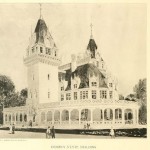George Winter, painter of Indiana ‘s Native Americans, was born in England in 1809. He exhibited a talent for painting early in life, and eventually moved to London to refine his skills. When his parents emigrated to Cincinnati, he decided to follow and bring his art to the states. After five years of study at New York ‘s National Academy of Design, George moved west, and in 1837 arrived by stagecoach in Logansport, Indiana.
According to Winter, he came to the Wabash “for the purpose of seeing and learning something of the Indians and exercising the pencil in the [that] direction.”
George Winter holds a place in the history of America by documenting a vanishing culture as it fell to the expansion of the United States. Through his close association with the Miami and Potawatomi tribes, he not only sketched the likenesses of many great Native Americans, but he also documented the tribes and their activities. His journals also proved to be an invaluable account of the Miami and Potawatomi tribes, opening a window into a past that was soon to vanish.
George Winter continued painting into the 1870s, and his works have been heralded as accurate and important ethnographic documents, the epitome of mid-nineteenth century Native American art.






















